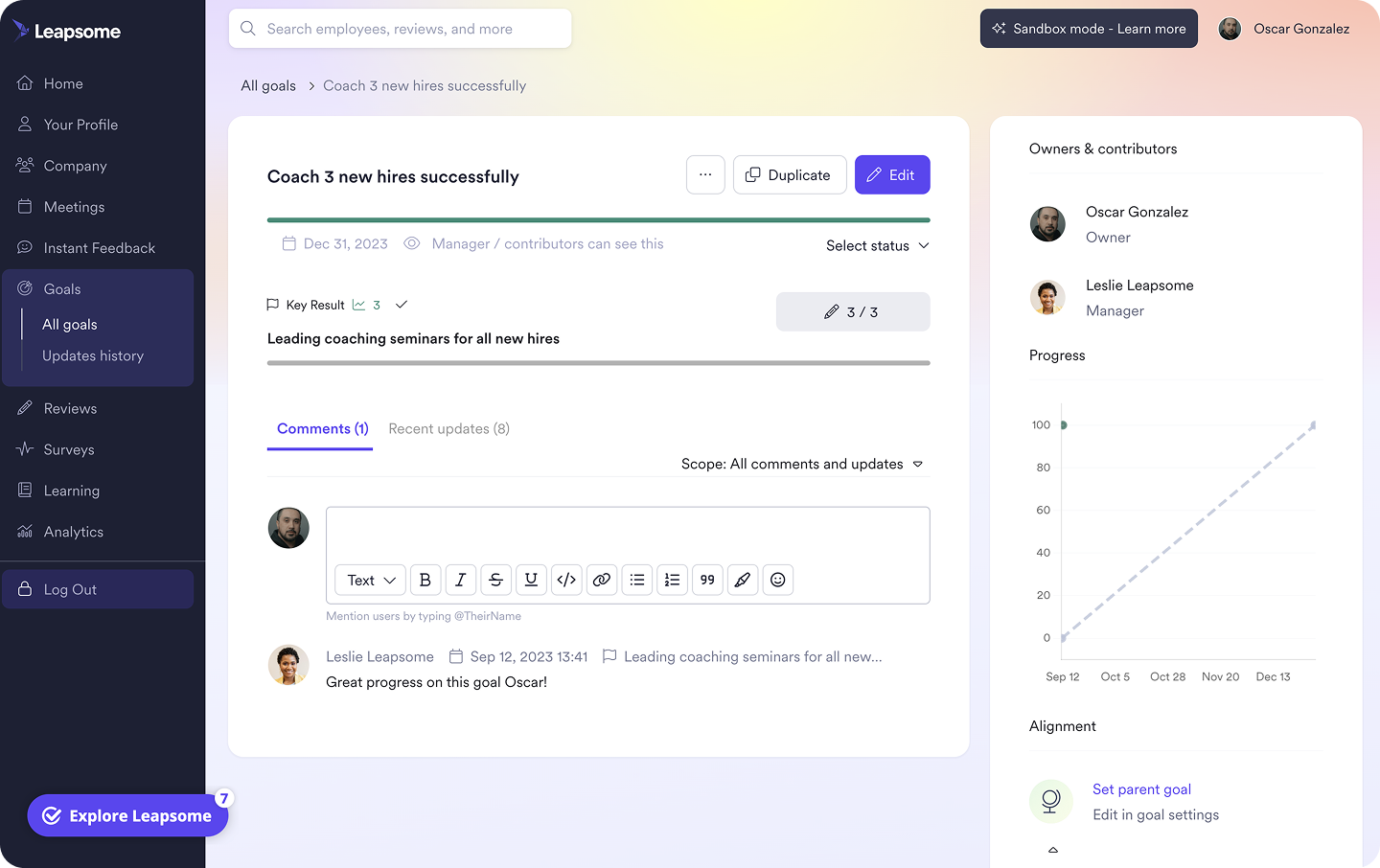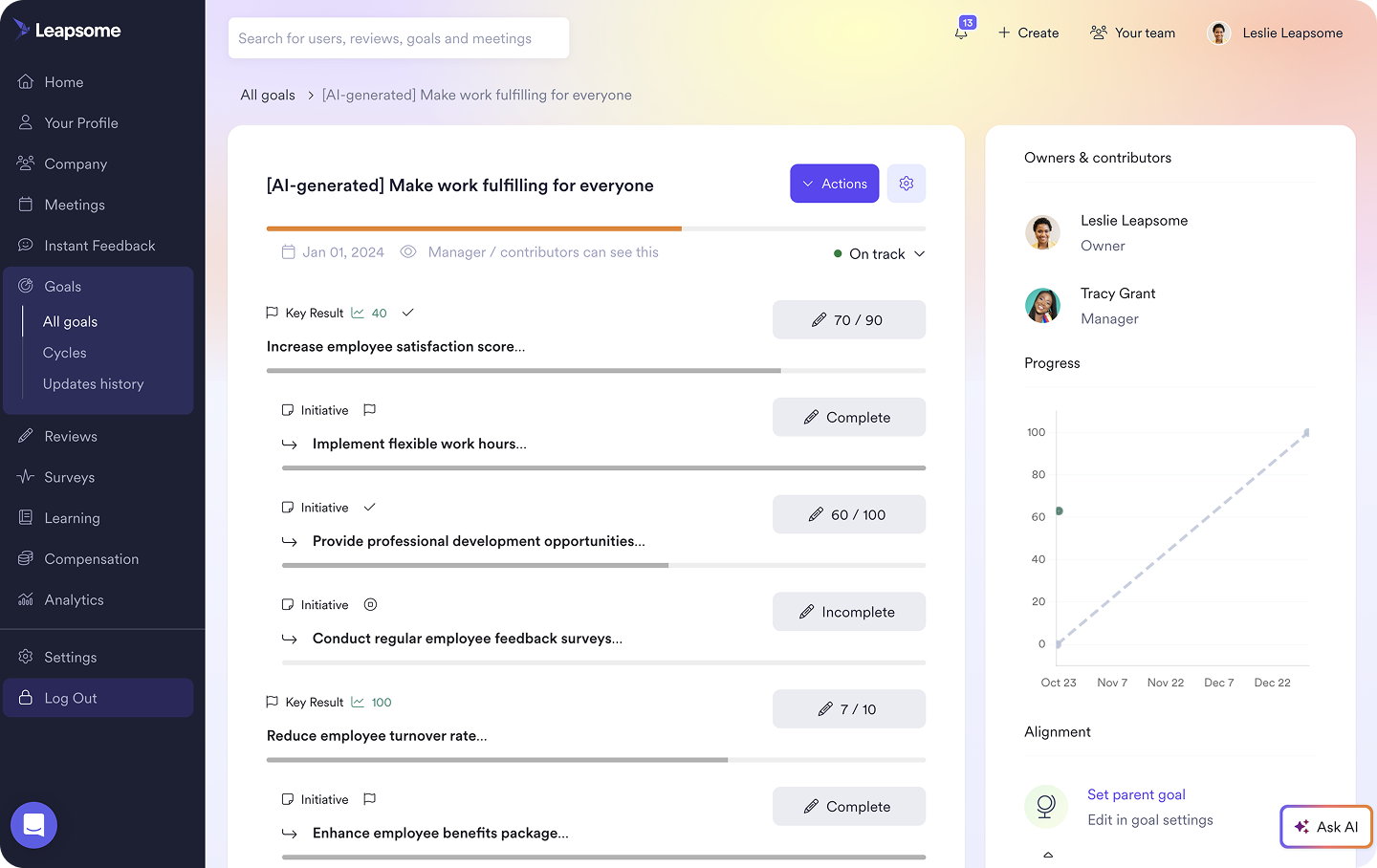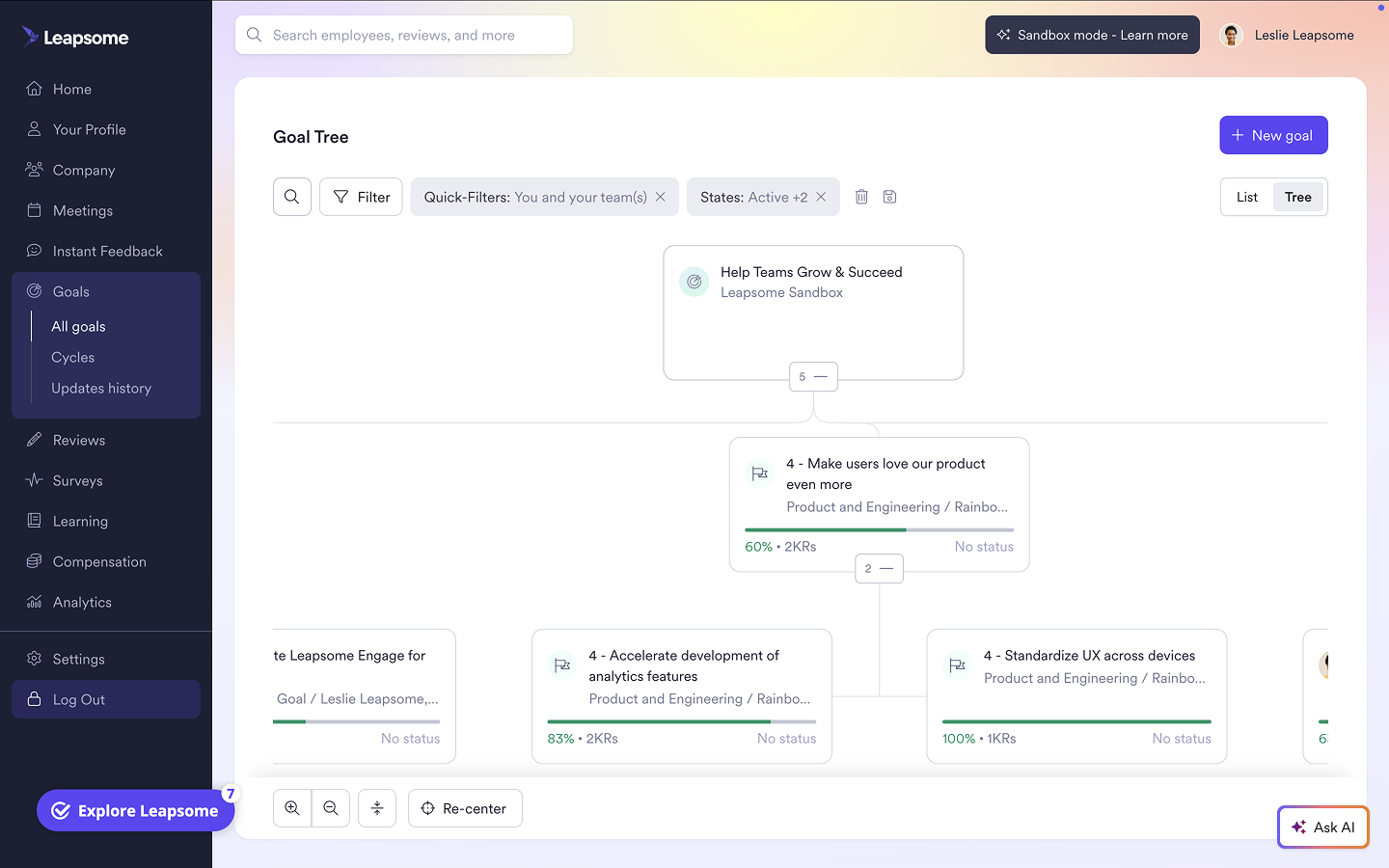.png)
TL;DR: Objectives and key results, or OKRs, are a popular business goal-setting system. They provide structure for goals, build team alignment, and ensure employees at all levels are working toward the same targets.
The OKR formula can be boiled down to: We will make progress in pursuit of [OBJECTIVE] by achieving [KEY RESULTS].
Objectives should be bold, motivating, and consistent with the company’s core mission.
Key Results define how you’ll reach your goals and track progress — so it’s important that they’re specific and measurable.

A simple explanation of OKRs, or objectives and key results, is that it’s a popular goal-setting framework that breaks ambitious goals (objectives) down into clear, manageable, and measurable outcomes (key results). It also encompasses initiatives, which are smaller-scale tasks, projects, and actions that team members complete to progress toward their key results.
Intel’s former CEO, Andy Grove, is known as the creator of OKRs, which he laid out as a strategic planning tool in 1983. While another Intel veteran, John Doerr, gave OKRs more visibility over the following decades, the methodology has become particularly popular over the last several years. They’re now used by fast-scaling startups and large corporations worldwide, such as Google.
💡 If you’re interested in learning more about the history of OKRs before you delve into this OKR implementation guide, we wrote a detailed article on their rise to popularity.
While OKRs aren’t anything new, understanding how to implement objectives and key results is particularly important in a difficult economic climate. When times are tough, organizations need to effectively prioritize their most critical work and make the best possible use of their resources. A clear, adaptable goal-setting framework like OKRs gives companies the tools they need to tackle issues before they get out of hand and ensure all team members at all levels contribute to the same business-critical outcomes.
Indeed, in the CFO Bookshelf podcast, Ben Lamorte, OKR expert and President of OKRs.com, points out that one of the key advantages of objectives and key results is that they allow colleagues to understand ‘goals’ in the same way. This results in more alignment and better equips teams to establish and work toward achievements that actually move the needle forward.
He explains, “By using OKRs, we create a common goal language. Just that alone, to me, can become a huge win for an organization to be able to even talk about goals, and to be able to do this across teams.”
🙏 Leapsome makes implementing OKRs easy
Discover all the ways our Goals module can align your team and propel you toward your objectives.
👉 Take a self-guided product tour
Although you might explore the same company-wide OKRs for an extended period, we recommend working with a quarterly cycle for team-wide and individual OKRs.
Quarters are an excellent match for OKRs because a 13-week timeframe allows you to aim for 10% progress each week, with a handy 2-3 week grace period to give you more wiggle room for when you’re starting out or need to make adjustments.
When considering how to implement OKRs within your organization, it can be helpful to consult a sample or two to get inspired. Let’s consider the following example of what we think is an excellent OKR:
Objective
The employee experience in our organization is so great that team members feel excited to share job postings with their networks whenever we have an opening.
Key results
💡 If you want additional support before you begin with OKR implementation, we’ve got the resources you need. Give our guide on making a great start with OKRs a read, as well as our detailed article on how to write OKRs.
We recommend this playbook to any CEO, people leader, or manager who wants to learn how to roll out OKRs or is looking to refine their organization’s approach to goal-setting.
Even if you already have some experience working with OKRs, it’s always a good idea to dig into how they differ from SMART goals and KPIs, brush up on the OKR methodology, or revisit the framework after an OKR cycle.
Where would you like to be within the next three to five years? This exercise can guide you to a more actionable goal-setting system.
Don’t stop at “Our vision is to be the #1 market leader.” Consider what needs to happen as you aim to get there. Do you need to double your ARR within the next "X" years? A more specific purpose will unfold into OKRs and support your vision.
Who this step is for: Managing directors/C-level executives
With a clear vision and priorities for the upcoming months/years, you can go one step further and translate these priorities into company goals.
Also known as parent goals, company-level goals will inform yet another, more granular level of OKRs (see next step), following a cascading goal methodology that aligns the entire organization.
Even when you’re working with quarterly OKRs, parent goals are often set for an entire year. Some common areas to focus on:
😍 Generate tailored OKRs with just a sentence and two clicks!
Leapsome Goals leverages AI to help you come up with effective OKRs lightning-fast.
👉 Explore Leapsome Goals
Who this step is for: Managing directors/C-level executives and team leaders
It’s time to understand the role that each team plays in reaching your company’s parent goals. You should now engage in conversation with each department’s leader to discuss how they can push your vision forward.
For example, your marketing department could support your hiring goals by working together with People Ops to launch an improved career page and promote the employee experience across social platforms. This same department could support revenue goals by driving more leads to your product or service.
Although, as mentioned, it sometimes makes more sense to set a longer timeframe to reach company-level goals, we recommend working with quarterly cycles for your team-specific OKRs.

Who this step is for: Department leaders and their teams
Between three and five objectives for each OKR period is a realistic amount to keep teams stimulated without feeling overwhelmed. Fewer goals may feel limiting and demotivating. However, with more goals, you risk focusing on too much at once and not achieving anything.
Who this step is for: Department leaders and their teams
Consider your team’s size, the complexity of your OKR system, and your objective’s scope before determining how many key results to put in place. You don’t want to set more key results because it looks more challenging. Remember that simplicity is crucial for success, and key results exist to help you reach your goals.
Engage your team by asking them how they can contribute to objectives rather than assigning top-down responsibilities to your reports. Ask yourself — and your team — several questions. Is there a need or space for a special project? Does someone want to tackle a particular aspect of the objective? How can the team and individual contributors push a goal forward?
By asking employees for their input instead of presenting a fixed plan, you encourage stakeholders to take the initiative, nurturing engagement and a sense of purpose. As a result, transparency and trust in your team’s capacity give room for thriving OKRs.
And remember: OKRs need to be aligned with the company’s goals. Although the department lead and their team will scope the OKRs, they need to be approved to ensure alignment.
Optional: Besides assigning ownership for team OKRs, you may also want to work with individual OKRs. Those could be, for instance, related to skills that you or a team member would like to develop and would, in turn, support your company’s growth and vision. However, we recommend individual OKRs for OKR-mature organizations only.

Who this step is for: All stakeholders
Keep your OKRs in shape by monitoring progress, making your goals an ongoing conversation, and recognizing every accomplishment. Praising your team for their achievements or considering them for a merit increase — no matter how big or small — is an excellent way to have everyone engaged and keep the potential of OKRs top of mind.
A best practice is to schedule an OKR check-in with your team every two weeks or every month. This way, you can address results and roadblocks, increase accountability, and work on solutions together.
All of these processes can be made much easier with the help of people management and goal-setting software. You and your team can be spared from manual work, easily updating and visualizing progress across your entire organization, thanks to goal dashboards, progress timelines, filters, and powerful analytics.
Goals don’t always go as planned, and there’s no shame in reevaluating objectives and key results during an OKR cycle. You may realize that a set of key results was unrealistic — or not audacious enough. You may even find out that an entire set of OKRs doesn’t move the needle for company-wide goals as expected. As always, be open to learning as a team; don’t wait until the end of a cycle to ask for support or raise red flags.
Each OKR cycle should invite questioning and curiosity. Encourage all managers and other contributors to evaluate key results when a cycle (e.g., quarter) approaches its end.
A best practice is to meet as a team to discuss results and learnings, aligning all stakeholders as they create more refined OKRs for the next period.
After agreeing upon individual and department-specific OKRs for a new cycle, schedule a retrospective and planning workshop with more stakeholders (perhaps even the entire company, depending on company size and operations) for more transparency and an even smoother alignment of cascading goals across the organization.
Objectives and key results constitute an impactful goal-setting methodology that has the power to motivate and inspire team members, align employees across all levels of an organization, and propel companies toward their most ambitious goals. However, implementing OKRs for the first time or improving your business’s approach can be a challenge.
Leapsome Goals is the partner you need in every step of your objectives and key results implementation process. Our tool can help you establish quality OKRs more quickly with the power of AI, set up automatic objectives and key results cycles to reduce repetitive admin, and track progress in a meaningful, actionable way.
Our Goals module also integrates with our Reviews and Meetings products, so OKRs will be front-and-center in discussions about recognition and development. Because Leapsome knows that a strong, holistic approach to goal-setting is essential for any ambitious organization in the current world of work.
🚀 Align and motivate your organization with OKRs
Leapsome Goals empowers you to implement OKRs and reach your most ambitious objectives faster.
👉 Book a demo

Although you might explore the same company-wide OKRs for longer, we recommend quarterly team-wide and individual OKRs. The reason quarters are an excellent match for OKRs is that a 13-week timeframe allows you to aim for 10% progress each week, with a handy 2-3 week grace period to get going and adjust your route.
If necessary, yes. The OKR-setting process should be thorough enough to only be changed if new information becomes available or if circumstances change. Yet, reevaluating objectives and key results during an OKR cycle has nothing to do with failure.
If a set of key results proves to be unrealistic, you may have to dial back. Or, if an OKR cycle has just begun and your team is already about to reach 100% of the key results, you might want to take them a step (or two) further.
What’s crucial to success is closely tracking progress and staying aligned with your team by scheduling OKR check-ins (see part 6 of our step-by-step instructions).
Coupling OKRs with compensation is not a best practice. Achieving results is part of good performance and should be considered when evaluating raises and promotions, but making OKRs a decisive compensation factor is likely to keep your company stuck. Why? Let’s revisit some of what we’ve discussed: Objectives should be audacious. And the “sweet spot” for OKRs will be somewhere between 60 and 80% of key results. So what happens when OKR results directly impact your employees’ livelihood? The answer is that, understandably, your team might be more conservative when setting up an OKR cycle — and this is likely to hinder individual development.
Shooting for the moon demands commitment and excitement, not fear.
Common mistakes are:
• Not frequently tracking progress;
• Not aligning OKRs with your company’s vision;
• Not working with your team as you define OKRs for a cycle;
• Not communicating with all stakeholders;
• Setting unrealistic OKRs;
• Setting too-conservative OKRs;
• Setting too many objectives;
• Setting too many key results;
• Having key results that are not measurable (e.g., if you want to “increase quality,” you need to measure it);
• Not defining ownership for key results;
• Only working towards OKRs at the very end of a cycle;
• Not aligning OKRs of different teams.
KPIs are an abbreviation for Key Performance Indicators. While KPIs evaluate how effectively your company performs a particular activity, the key results in OKRs are guided by objectives anchored in an overarching mission.
KPIs and key results should be quantifiable and might even speak to the same achievements (e.g., number of qualified leads in a quarter). However, unlike OKRs, KPIs aren’t necessarily guided by a broader vision — and it’s this vision that’ll help you keep your team aligned and focused.
SMART is an acronym for specific, measurable, achievable, relevant, and time-bound. This framework is very helpful to elaborate a single goal, but it doesn’t tackle the interconnectedness and organizational alignment offered by OKRs. The good thing is that you can combine both these frameworks, making your key results, the most granular part of OKRs, SMART (again: specific, measurable, achievable, relevant, and time-bound). You can also apply the SMART methodology for goals that don’t connect with your company’s overarching vision (e.g., individual development goals).
Learn how Leapsome can automate, connect, and simplify your HR processes.
.webp)
.webp)
 Book your demo
Book your demo


Run smooth operations with our easy-to-follow how-tos and best practices for all things People Ops
Mit unseren leicht verständlichen Anleitungen und Best Practices für People Ops sorgen Sie für reibungslose Abläufe.